

|
Back to |
| The Front Page |
| Letters & Opinion |
|
Time is a cruel master but liberation is possible a fact-based editorial by Bob Alman layout and illustrations chosen and arranged by Reuben Edwards posted December 14, 2015
|
If David Drazin were still with us, he'd gladly write a scholarly examination on THE HISTORY OF TIME IN CROQUET. I'd welcome a good effort from any quarter; here's my own. My experience--as local club president, event manager, organizer of a huge croquet facility, and tournament director--has convinced me that the influence of time as an element in the game should by any and all means be eliminated or greatly reduced. This fact-based editorial is about how that might be achieved, in both the American Rules game (where the element of time approaches the level of atrocity) and in Association Croquet (where time is the aspect most likely to produce the dreaded "unfairness" we all want to avoid in our tournament formats). Will you help in this crusade? Don't tell me you don't have time....
Everybody who knows me knows I really love the American version of croquet, despite and maybe even because of its imperfections and oddities. I do acknowledge, however, that if you're from the planet Mars--or for that matter, from Australia--the American obsession with time, as seen in an American Rules croquet game, looks very weird when you first encounter it.
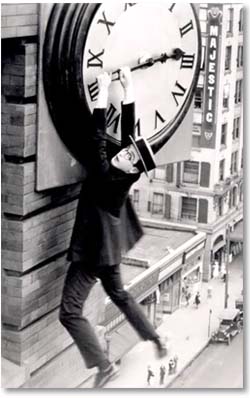
|
At a certain point the game-time keeper shouted loudly, to make sure the players would hear, "ONE MINUTE REMAINING," and after a beat or two came the call from the shot-clock time keeper, "FIFTEEN SECONDS!" and it was just too thoroughly American a spectacle for Tony to handle with equanimity. He burst out laughing and suffered a long spasm of giggles at courtside, politely trying not to attract attention.
It made an impression on me, too--because I saw, if only for an instant, our strange American croquet culture through Tony's eyes. It's easy to understand why foreign players who witness it for the first time see it as absurd.
My theory about why this absurdity persists is similar to the arguments my ancestors used to perpetuate slavery in the American South long after the rest of the civilized world had given it up: We were accustomed to it, and so were our slaves, many of whom declared that the condition was good for them and good for everyone.
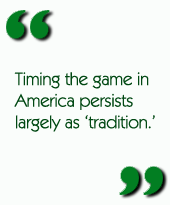
Americans have eliminated legal slavery for picking cotton, but we croquet players are too often slaves to the clock, measuring all the units of time in a croquet game, I think, because of our history: Less than 40 years ago, in the beginning of organized croquet in America, there were very few purpose-built croquet courts, so the time allocated to the courts available for events had to be closely managed. One result was that short, timed games became the norm. That "norm," in my view, has persisted long past any necessity for it in most major American Rules tournaments. It persists largely as "tradition."
It's relevant to note, at the same time, that today at the top level in American rules, the winner of Championship Singles almost always pegs out. In some tournaments, the timing of the finals is not specified in the event guide; in others, a best-of-three format is scheduled, and all the games go to the peg. (My suspicion is that the players in these top-level games--all of whom compete seriously in Association Croquet as well--would be embarrassed to be suspected of "playing the clock" in the American game in front of the gathered spectators.)
A successful experiment has not led to changes
As tournament director, in the last two years of the San Francisco Open, perhaps inspired by the Tony Hall spectacle, we successfully experimented with "timeless" games to the peg in the Championship flight. We found that most games ended well before the 120 minutes we scheduled for each game slot, including double-banked singles games.
| SHOT-CLOCK ENTITLEMENT: IT'S LEGAL, BUT IS IT ETHICAL? |
|
The traditional and persisting conflation of rules and conventions in the game, court etiquette, and common courtesy all combine to create an unfortunate persisting condition in time-limited American rules games: you will often see on the same court, in the same game and playing as competitors, players whose radically different and contradictory convictions reveal themselves as irritation and discord. Given the murkiness of the rule book, there's nobody to blame; the two sides are equally "right." The "literalist" will insist on considering the 45-second shot-time limit an entitlement to be used at any point of the game for any reason; and will in good conscience decline to go through one-back in order to take tactical and/or strategic advantage of the opponent's deadness. Leading by a few points with the opponent balls separated, this player may even stand in the middle of the court two feet from the peg waiting for the game clock to expire on last turn before pegging out one of his balls--denying opponent one crucial turn. All the while, the "liberal" opponent will mutter under his breath, "It's legal, but it's not ethical" as fervent comment on all these time-based manipulations. Extra rotations at the end of game time--though not a complete solution--would restore some element of fairness (and ethics) into the game for everyone; the expectation of extra turns at the end of clock time might also discourage the in-player using tactics (such as "wasting time") regarded by many players as "legal but unethical." Most importantly: there would be less stress and more enjoyment in the game for everyone.
|
The "cost" of scheduling games off the gamelock was the surrender of one of our previous six game periods a day: We had scheduled 90-minute timed games in all flights, within 1:45 game periods, and one 30-minute break for lunch, beginning at 8:30. With the timeless schedule, we started our five two-hour game periods at 8:00 AM, with the final period of the day scheduled for 4:00 PM, allowing up to 90 minutes extra for running overtime, until 7:30. And we envisioned the possibility of completing "pegged down" games at the end of the day, if that should be necessary. (As it turned out, it wasn't.)
Naturally, we encouraged players to start early whenever possible, and we encouraged "expeditious play." so in both years, we ended early in the Championship Flight, with some games ending in less than an hour.
We had demonstrated that games played to the peg with no time limits are practical and workable in the top flight--especially at larger venues with more court capacity and scheduling flexibility.
Since then, I have successfully conducted time experiments with the less expert levels of play at the National Croquet Center with "Wharrad turns"-- multiple rotations after game time expires. This less-than-ideal solution nevertheless enables players to put their attention on the game rather than on the clock in the final rotations. (One complete rotation of four balls beginning with the ball in play when gametime is called is already mandated by the American rules.) The simple expedient of one extra rotation is a practical way of addressing much of the anxiety of BOTH players about "wasting clock time" as a strategy--both the fact and the appearance.
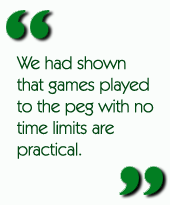
Venues like the National Croquet Center in Florida or Mission Hills in California, with an abundance of courts to handle the occasional over-time situation, make both these options--games to the peg and/or extra turns-- really practical.
Longtime American croquet pro Bob Kroeger observes that there actually is no shot clock kept in most tournaments these days, and therefore no actual way to police time-wasters. But, he comments," most players know if they've gone longer then 45 seconds, and having no shot clock seems to give them license to break the time-limit rule. Another flawed concept (at least in the northeastern US) is that shot times in last turns are unlimited."
Kroeger's observations seem to mirror the fears of many Association Croquet players that citing a limit in AC for shot times will be interpreted as entitlement. And that's exactly how many American players view the 45-second rule; many of them insist on principle--and this is at the top level of play--that they are entitled to deliberately go to the limit on that shot-clock time as a way to hang onto a lead in the game.
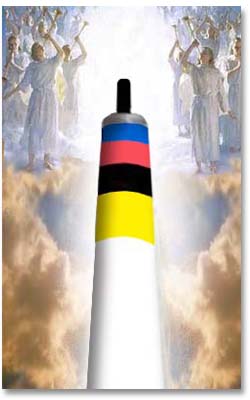
|
Bob Kroeger wrote to me, " I think it's unacceptable to have in the beginning of the rule book a statement that says, "The striker must plan and play shots throughout a game with reasonable dispatch," while the actual rule says, 'In a time limit game the striker shall have a maximum of 45 seconds to strike the striker ball following the completion of the previous shot.' In my opinion, tournament croquet is a farce if you 'guilt' a player into playing fast when there is a near certainly that if you time manage within your 45 seconds you will win."
Kroeger depises this self-contradiction of the American rules. "The murky phrase 'reasonable dispatch' shouldn't be anywhere in the rules section, if it's talking about etiquette rather than 'laws' applying to the rules of play. Where would you find a qualified human being willing to watch each game as a non-biased observer and responsible for ruling on 'reasonable dispatch.'? Any player, including a top-ranked one, is entitled to follow the letter of the rules at any point in a timed game, and do what he needs to do within the rules to win. Why would anyone who wants to win do anything else? It should not be considered a violation of either rules or etiquette."

As for Association Croquet, "To me it's ridiculous not to have two last turns per side in timed AC games," Kroeger said. "This would help to make stalling useless. One of the reasons I've done reasonably well at the Selection Eights--along with solid breaks and good tactics--is that there are no time limits."
Kroeger favors the extra complete rotation at the end of American rules games as well. It isn't in the rule book, but it isn't prohibited either. Presumably, tournament directors are allowed to manage game and match times in their events as they see fit.
"But it's a different game, without time!"
That's what the critics say, and they are right! An almost imperceptible but very clear result is......faster games! Nobody has any reason at all to delay on any stroke, or in American Rules, to decline to run one-back. All the attention is paid to getting to the finishing peg first--the destination designed into the game to let you know who has won and who has lost.
Moreover, many players--especially at the top level--in their "practice" games outside a tournament format, routinely play relaxed "causal" games to the peg. Why should the pace and strategy of tournament games be any different?
And don't forget the Short Game
| TIMING A GAME OF GOLF |
|
Imagine a two-person golf tournament on an 18-hole course with a time limit of four hours. You're thinking, "That's crazy!" but there could be excellent reasons for the time limit, and not all of them have to do with television coverage, advertising revenue, and other scheduled broadcasting. With a time limit, there would also be the huge consideration of how and whether which player--especially towards the end with a tight score--is forcing the opponent (however politely) to "eat the clock" in the closing minutes. One compensating benefit to the uncertainty caused by the time limit could be the expanded possibilities given the two-man commentator team:
MIKE: He's taking a lot of time on this stroke.
Would it be a positive change? I would say, "No, definitely not." What would you say? The murky and conflicting rules of "expeditious play" and "stroke time" are firmly embedded in American Rules croquet, which should be a warning to those who advocate doing it in Association Croquet.
|
So why is the Short Game such a failure, in both Association and American rules? I suspect the thoughts and emotions driving its unpopularity are similar to those behind the reluctance of the 85-handicap golfer to play on a par-3 course, or the 10-handicap croquet players to compete in Golf Croquet on a half-court.
The rules in AC are less murky and confused with regard to "shoulds" and "should nots" which are linguistically beyond the purview of referrees and TDs--although Bob Kroger, for one--who plays and directs events in both formats--says he always comments on the issue of "time" at the start of his events as a personal opinion--urging expedition in play and counseling again using the 45-second shot clock limit as an entitlement--that unfortunately carries no weight with the players, given the ambiguity of the American rulebook on those points. And as a back-up, he likes to provide at least one extra rotation after game time in both formats.
The point is: croquet games played to the peg with no time limit are workable in the top flight at larger venues with more court capacity and scheduling flexibility; and games with multiple rotations after time in the lower flights address the same issue, helping players to put their attention on the game rather than on the clock.
Time in Association Croquet
Association Croquet at top level is usually intended to be played to the peg, even when the best-of-three or even a best-of-five format is employed for the finals and sometimes the semi-finals as well. In reality, they still have time limits set long enough for the games and matches to (probably) finish, but short enough (hopefully) for the event not to overrun to the following Monday.
For the few spectators with the time and patience to stick it out, the main thing to witness in these marathon match exertions--in addition to the grooms and lifts--is the break-downs. The more there are, the more likely the player most proficient in all the elements of the game will win the contest.
But because of the fear of an "unfair" result when the lesser player is "lucky" on too-easy courts with too-easy hoops, much attention these days is being focused on changing from best-of-three formats to best-of-fives--which extends the "maximum" time of a best-of-five match to 10 1/2 hours. So it's quite possible that in addition to driving away all the spectators, an "untimed" best-of-five match might actually include one or more games that don't go to the peg!

The formula most used for timing best-of-three matches is, in the order of the three games, a minimum of 4, 7 and 9 hours cumulatively. For best-of-five matches, the numbers proposed are a minimum of 3, 5˝, 7˝, 9 and 10˝ hours cumulatively.
James Hawkins of Liverpool points out that time limit games are not in the main body of the laws of croquet, but are mentioned in an appendix on tournament regulations, as a convenience for tournament managers wanting to achieve a manageable schedule. But, "I'd be uncomfortable about getting a reliable result if the limit was cut shorter than two and a half hours."
And Hawkins see many advantages of having no time limit: "There would be no disputes about time wasting. Players would be more relaxed about double-bankers dithering around their hoop for twenty minutes. And, curiously, untimed games don't seem to last much longer. There may be a change in mindset, by which slow players actually knuckle down and play for a peg-out finish rather than scraping a ball-in-each-corner one-hoop-advantage win."
French explains English time
Martin French, former Secretary-General of the World Croquet Federation, has confronted "time" issues often over many years, as both a tournament director and referee. He notes that the AC laws require "expedition in play" without defining precisely what that means in seconds and minutes. But, "The tournament referee has the power to put a ref in charge and take sanctions against any individual player. The tournament director can put a time limit on an individual game if it is dragging on, but not I think to penalise a player for slow play."
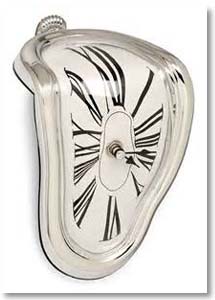
|
"I then took a chair by the side of the lawn and I found that if a player was unnecessarily slow, simply getting slowly to my feet was enough to get the player to get on with it--so I haven’t actually ever had to impose a penalty!" The referee has genuine power in such a situation to affected play just by his courtside demeanor.
French notes, "The tournament referee has the power to put a ref in charge and take sanctions against any individual player. The tournament director can put a time limit on an individual game if it is dragging on, but not I think to penalise a player for slow play."
According to French, "The tide seems to be turning against time limits in Golf Croquet now. Several events which had time limits a few years ago now either have none or they have been extended so they very rarely come into play--a definite improvement. I would like to see no time limits in Golf Croquet.
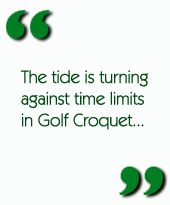
"The WCF does set down Golf Croquet time limits for its own events, but has some words around them like "normally we'd expect these events not to be subject to time limits, but if the manager decides they are necessary, they mustn't be any shorter than these...."
Colin and the late Christine Irwin used to spend winters in Venice, Florida playing mostly American rules and playing the other six months in England, all Association Croquet. Chris told me that virtually all the tournaments in the UK are time-limited, except the big championships such as the Opens, Mens, Womens, and President's Cup. She drew a distinction between slow play and choosing not to run 1-back in American rules: "I see choosing not to run one-back as a valid defensive tactic that a player may adopt at will. I have no issue with my opponents using it when I have deadness, and I sometime use it too. I find that the general ethos and attitude of the American club where the players acquire their habits is a factor in whether players are slow and run the clock or not."
Time in Australia can be measured six different ways
| THE TOURNAMENT FAIRNESS MAGIC FORMULA MADE SIMPLE |
|
(managed with expert "touch shots") + undulating, textured surface (calling for expert "reading" of the lawn) + tight and sticky hoops (requiring precise and close set-ups) = Many turn-overs and hit-in attempts in an "obstacle course" that guarantees the best player achieves a just victory in no more than three match games
|
The problem is, though, that "most competitions are controlled by one of the six state assocaitions, and they have the power to adopt their own rules. I am familiar only with Croquet New South Wales, and all games controlled by this body are time limited, and have been since I became a referee in the late 1980s.
"However, I have a handbook dated 1954 of the N.S.W. Croquet Association (as it then was) which contains the laws of the game and lots of regulations and rules but no mention of clocks." As to extra turns at the end, "I have never heard the name Wharrad used in Australia, and I am not sure I know what it means."
Nattering on the Nottingham
The issue of "time" comes up regularly on the Nottingham Board, and as with most such conversations, usually come to something like the same conclusions each time. Chris Clarke, who minces neither words nor opinions, commented on the board, "Having played in the last Golf Croquet Worlds, I really struggled to find the motivation to focus during some of my later block matches (that's 9 best of 3's in 5 days). We then spent Day 6 reducing the successful 32 qualifiers down to 8. Five days of almost irrelevance followed by one day of carnage. Completely bonkers."
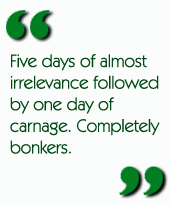
The top-level players, quite naturally, would like to see the top players emerge quickly from the blocks--even though organizers recognize that top-level competitions are not only about the winners, but also about the players who are pleased and proud just to be able to compete, and very intent on just getting out of the blocks and qualified for the match-play knock-out.
The now-conventional blocks of eight, for example, with the top four qualifying from the blocks (whether they're single games or best-of-three matches) might instead be blocks of four, with the top two qualifying.
Or even blocks of eight might have only the top two qualify, which would give more playing time to the aspiring champions not likely to make it to the final knockout stages.
But Martin French points out that running a major event with the objective only of making sure that the best player wins might drive most competitors away from the event entirely, devaluing it for both winners and losers as well as for the sponsoring organizations.
And all of this conversation takes place within the assumption that no really workable time formula for best-of-fives is likely ever to be found.
Is there any way out of this conundrum? Yes, there is! And it's both practical as well as totally revolutionary! Read on.
|
HOW TO GUARANTEE A FAIR RESULT IN A SHORTER SPAN OF TIME Whenever someone mentions the need to "make the game more challenging" I think of Jerry Stark's "super-court" at Meadowwood in Northern California, which combined two full-sized courts, doubled all the distances, and vastly increased the difficulty of hitting in, creating breaks, and playing them. It was thus more "fair" as a contest of skill than the regulation would be, but it was inefficient as a means of making the game more difficult: It doubled the space necessary and was played on a moderately fast surface that was level and evenly textured. It was a cute idea but not a solution to anything. A truly challenging court would be efficient both in the space required and in the tournament time necessary to achieve a "fair" result in competition. Instead of expanding it, the regulation-size court could be given a very fast surface with small undulations in the level and perhaps varying textures of grass or other court covering, and then set with really tight and hard-to-run hoops. All of this has been done in the past--either accidentally or purposefully--and recommended by highly respected champions. Keith Wylie was an advocate of terrained courts, and more recently Chris Clarke has championed the development and use of the super-challenging Quadway hoop. By combining all those factors, you will with little doubt produce the interactivity which ultimately all but guarantees that the more skilled player will win--the player who can best hit in and manage the breakdowns to create over the long term the best likelihood to stay in the game and control the circuit of the balls around the court, all the way to the peg. Clarke of New Zealand has done the most and best work in pioneering ways to achieve the "fairest" results in top-level competition--engineering the fast lawns of United and ultra-tight and "sticky" Quadway hoops featured in the last MacRobertson Shield team competition. All of that was intended to provide more interactive games (meaning more "breakdowns" and turnovers) which not only tested the players' skills in each turn, but also provided some element of interest to spectators who otherwise--on an "easy" court--would have to watch a half-hour one-man exhibition as the in-player sets up a triple, allows the out-player to miss his one chance of getting back in the game with a lift shot, and then executes the final-turn peeling display. On an easy lawn with easy hoops, there's little to watch, really, except the way almost every shot fails to be "perfect" and how the players adjust each stroke for the marginal failure of the previous one. The more difficult the lawn is, the more interesting the play becomes--for both player and spectator--and the higher level of expertise required by the eventual winner of a contest everyone would finally agree was "fair." It's why Keith Wylie seriously proposed, decades ago, deliberately terrained courts requiring more expert "reading" of the surface, preparing for practical ways to handle the schedule requirements of major events as the skill level of top players has predictably continued to increase. The "easy" lawn is too slow, level, and of uniform texture. The "difficult" lawn, on the other hand, plays very fast, is not exactly level, and may have different degrees of speed depending upon the nature of the surface (clover, for example, doesn't play the same as grass). The time element of croquet will continue to be an issue so long as facility managers strive to make the courts ever more "perfect," which--and this is contradictory--potentially enables anyone in the top 100 to win a major event; the best sporting instincts of most croquet players would really prefer someone in the top 10 to PREDICTABLY win the top trophy and fairly earn the world championship title. On "easy" courts, that requires a lot of time. On "difficult" courts, it takes less time to get a fair result. How golf courses could be "perfected" Golf courses are designed to present varying challenges for the players as they work hard to achieve a good result on a variety of deliberately contoured surfaces. How interesting would it be to play 18 holes of golf on a course with perfectly flat links and putting greens? How much fun would it be to watch such a spectacle? So consider the paradox of croquet. We try to create "perfect" greens and then have to play over-long tournaments on them in order to assure ourselves of a fair result. Does that make good sense? Time alone has today become the most important element in determining the "fairness" of a contest. That's what makes the tournaments so long and so tedious in producing a fair result. An untimed best-of-three match can give you a fair result The single-game determinant of excellence has not been respectable for decades at top level, except in the long-gone Sonoma-Cutrer World Championship, which the lavishly subsidized players were glad to play under easy conditions and aim for the final through the "Patmor draw" devised in the 80s to manage the shortage of time for an event played on only two fairly easy courts over a week. In the year 2015, the issue of time has come down to whether the finals need to be best-of-three or best-of-five to be fair. "Best-of-three" formats are now considered the minimum. "Best-of-five" finals consume an entire day; it's almost impossible to devise a game/match formula that really works in all cases. Although a successful formula has been found for managing time in only one day in a best-of-three format (which gives the early games potentially more time, with carry-over to subsequent ones, allowing the match to end in less than ten hours) there is no good formula for completing a best-of-five in one day without confronting the possibility of ending the later games short of the peg. But if all the factors of "difficulty" outlined here were designed into our courts and events--hoops, surface texture, terrain, and speed--SURELY the best-of-three format would be sufficient to ensure as "fair" a contest as possible, even for the finals, in one day. Tournaments would still be agonizingly long, for some. But their games would all be played to the peg. They would be "fair." They would be more interesting to watch. Decades ago, certain venues were famous for their peculiarities, in the same way that golf courses achieve their just notoriety--for their distinctive terrain and surfaces textures. A back-to-the-future solution to an escalating problem could become just as popular with builders and planners of croquet facilities as with players and spectators. They might even help us make croquet popular again!
|